An Innovative Material with Strong Frost Resistance—Concrete Containing Dolomite Powder
Abstract
:1. Introduction
2. Experimental Details
2.1. Materials and Mixture Preparation
2.2. SEM Test
2.3. Test Design of Chloride-Penetration Resistance
2.4. Test Design of Frost Resistance Durability
2.5. Mass Loss Rate Test
2.6. Relative Dynamic Elastic Modulus Test
2.7. Establishment of Damage Model of Concretes Incorporating Dolomite Powder Based on Two-Parameter Weibull Distribution
3. Results and Discussion
3.1. SEM Test
3.2. Chloride-Penetration Resistance Test
3.3. Damage Shapes of Different Freeze–Thaw Cycles
3.4. Mass Loss Rate of Different Freeze–Thaw Cycles
3.5. Relative Dynamic Elastic Modulus of Different Freeze–Thaw Cycles
3.6. The Influence Mechanism of Water-to-Binder Ratio and Dolomite Powder on the Concrete Properties
3.7. Damage Model of Concrete Incorporating Dolomite Powder Based on Weibull Distribution
4. Conclusions
Author Contributions
Funding
Data Availability Statement
Acknowledgments
Conflicts of Interest
References
- Korjakins, A.; Sahmenko, G.; Bajare, D.; Bumanis, G. Application a dolomite waste as filler in expanded clay lightweight concrete. In Proceedings of the 10th International Conference Modern Building Materials, Structures and Techniques, Vilnius, Lithuania, 19–21 May 2010; pp. 156–161. [Google Scholar]
- Xiao, J.; Wu, T.; He, Y.Q.; Tian, C.Y.; Xu, Y. Rheological properties of cement-ground dolomite. Bull. Chin. Ceram. Soc. 2016, 35, 891–896. [Google Scholar]
- Machner, A.; Zajac, M.; Haha, M.B.; Kjellsen, K.O.; Geiker, M.R.; Weerdt, K.D. Limitations of the hydrotalcite formation in Portland composite cement pastes containing dolomite and metakaolin. Cem. Concr. Res. 2018, 105, 1–17. [Google Scholar] [CrossRef]
- Zhang, S.; Lu, D.Y.; Xu, J.T.; Ling, K.; Xu, Z.Z. Effects of dolomite powders on the early hydration properties of blend cement and its mechanism. J. Nanjing Technol. Univ. (Nat. Sci. Ed.) 2017, 39, 60–65. [Google Scholar]
- Huang, X.P.; Zhang, Q.; Guo, S.Y.; Wang, G.W. The present state and future outlook of the exploitation & utilization of magnesium resource in sea water and brine about our country. Sea-Lake Salt. Chem. Ind. 2004, 33, 1–6. [Google Scholar]
- Jiang, W.; Jiang, S.X. Preparation and applicationo of magnesium cement by caustic dolomite and calcined magnesite. J. Guilin Univ. Technol. 2012, 32, 588–595. [Google Scholar]
- Xie, X.L.; Yan, Y.; Hu, Z.H. Effect of Light-burnt Dolomite on Performance of Portland Cement. China Non-Met. Min. Ind. 2012, 5, 36–40. [Google Scholar]
- Petrounias, P.; Giannakopoulou, P.P.; Rogkala, A.; Lampropoulou, P.; Tsikouras, B.; Rigopoulos, I.; Hatzipanagiotou, K. Petrographic and mechanical characteristics of concrete produced by different type of recycled materials. Geosciences 2019, 9, 264. [Google Scholar] [CrossRef] [Green Version]
- Lampropoulou, P.; Petrounias, P.; Giannakopoulou, P.P.; Rogkala, A.; Koukouzas, N.; Tsikouras, B.; Hatzipanagiotou, K. The effect of chemical composition of ultramafic and mafic aggregates on their physicomechanical properties as well as on the produced concrete strength. Minerals 2020, 10, 406. [Google Scholar] [CrossRef]
- Stukovnik, P.; Bosiljkov, V.B.; Marinsek, M. Detailed investigation of ACR in concrete with silica-free dolomite aggregate. Constr. Build. Mater. 2019, 216, 325–336. [Google Scholar] [CrossRef]
- Peng, Y.; Gao, Y.X.; Zhao, R.X.; Wu, Y.Y.; Jia, L.L.; Chen, B.J.; Huo, L. Experimental study on dolomite powder as concrete admixture. China Concr. Cem. Prod. 2014, 6, 13–16. (In Chinese) [Google Scholar]
- Ye, H.l.; Fu, C.Q.; Yang, G.J. Influence of dolomite on the properties and microstructure of alkaliactivated slag with and without pulverized fly ash. Cem. Concr. Compos. 2019, 13, 224–232. [Google Scholar] [CrossRef]
- Xu, J.T.; Chen, J.W.; Lu, D.Y.; Xu, Z.Z.; Hooton, R.D. Effect of dolomite powder on the hydration and properties of calcium sulfoaluminate cements with different gypsum contents. Constr. Build. Mater. 2019, 225, 302–310. [Google Scholar] [CrossRef]
- Yan, J.J.; Deng, C.; Ye, X.S. Study of the effect of specific surface area of dolomite rock powder on properties of cement mortar. China Concr. Cem. Prod. 2018, 3, 7–10. (In Chinese) [Google Scholar]
- Garcia, E.; Alfonso, P.; Labrador, M.; Gali, S. Dedolomitization in different alkaline media: Application to Portland cement paste. Cem. Concr. Res. 2003, 33, 1443–1448. [Google Scholar] [CrossRef]
- Zhang, X.Y.; Glasser, F.P.; Scrivener, K.L. Reaction kinetics of dolomite and portlandite. Cem. Concr. Res. 2014, 66, 11–18. [Google Scholar] [CrossRef]
- Tian, Z.Z.; Chen, D.; Zhang, Y.; Zhang, S.T.; Ren, F.C.; Xu, S.Y. Effect of dolomite powder fineness on hydration properties of dolomite-cement. Non-Met. Min. 2021, 44, 11–14. [Google Scholar]
- Krishnan, S.; Bishnoi, S. Understanding the hydration of dolomite in cementitious systems with reactive aluminosilicates such as calcined clay. Cem. Concr. Res. 2018, 108, 116–128. [Google Scholar] [CrossRef]
- Xu, J.T.; Lu, D.Y.; Zhang, S.H.; Xu, Z.Z.; Hooton, R.D. Reaction mechanism of dolomite powder in Portland-dolomite cement. Constr. Build. Mater. 2021, 270, 121375. [Google Scholar] [CrossRef]
- Stefan, J.; Hans, C.G. High strength concrete freeze/thaw test and cracking. Cem. Concr. Res. 1995, 25, 1775–1780. [Google Scholar]
- Veniamin, D.K. An evaluation of frost actions on concrete. Concr. Int. Des. Struct. 1996, 18, 42–43. [Google Scholar]
- Hanjari, K.Z.; Utgenannt, P.; Lundgren, K. Experimental study of the material and bond properties of frost-damaged concrete. Cem. Concr. Res. 2011, 41, 244–254. [Google Scholar] [CrossRef] [Green Version]
- Bao, J.; Xue, S.; Zhang, P.; Dai, Z.; Cui, Y. Coupled effects of sustained compressive loading and freeze-thaw cycles on water penetration into concrete. Struct. Concr. 2020, 22, E944–E954. [Google Scholar] [CrossRef]
- Liu, K.H.; Yan, J.C.; Alam, M.S.; Zou, C.Y. Seismic fragility analysis of deteriorating recycled aggregate concrete bridge columns subjected to freeze-thaw cycles. Eng. Struct. 2019, 187, 1–15. [Google Scholar] [CrossRef]
- Oh, B.H. Fatigue analysis of plain concrete in flexure. J. Struct. Eng. 1986, 112, 273–288. [Google Scholar] [CrossRef]
- Oh, B.H. Fatigue-life distributions of concrete for various stress levels. ACI Mater. J. 1991, 88, 122–128. [Google Scholar]
- Guan, Y.G.; Sun, W.; Miao, C.W. One service-life prediction model for the concrete based on the reliability and damage theories II: Verification and application of the model. J. Chin. Ceram. Soc. 2001, 29, 535–540. [Google Scholar]
- Qiao, H.X.; Guo, X.K.; Zhu, B.R. Accelerated life test of concrete under multiple factors Based on three-parameter Weibull distribution. Mater. Rep. 2019, 33, 639–643. [Google Scholar]
- Zhou, J.L.; Zheng, M.; Wang, Q.; Yang, J.G.; Lin, T.F. Flexural fatigue behavior of polymer-modified pervious concrete with single sized aggregates. Constr. Build. Mater. 2016, 124, 897–905. [Google Scholar] [CrossRef]
- Chandrappa, A.K.; Biligiri, K.P. Flexural-fatigue characteristics of pervious concrete: Statistical distributions and model development. Constr. Build. Mater. 2017, 153, 1–15. [Google Scholar] [CrossRef]
- GB/T 50082-2009; Standard for Test Methods of Long-Term Performance and Durability of Ordinary Concrete, First ed. China Architecture & Building Press: Beijing, China, 2009.
- Brown, S.D.; Biddulph, R.B.; Wilcox, P.D. A strength-poroity relation involving different pore geometry and oritn-ration. J. Am. Ceram. Soc. 1964, 47, 318–322. [Google Scholar] [CrossRef]
- Guan, X.; Niu, D.T.; Wang, J.B.; Wang, Y. Study of the freezing-thawing damage constitutive model of concrete based on Weibull’s strength theory. Concrete 2015, 5, 5–13. [Google Scholar]
- Powers, T.C. A working hypothesis for further studies of frost resistance of concrete. J. ACI 1945, 16, 245–272. [Google Scholar]
- Powers, T.C.; Helmuth, R.A. Theory of volume change in hardened Portland cement paste during freezing. In Proceedings of the Thirty-Second Annual Meeting of the Highway Research Board, Washington, DC, USA, 13–16 January 1953; Volume 32, pp. 285–297. [Google Scholar]
- Dong, W.; Shen, X.D.; Xue, H.J.; He, J.; Liu, Y. Research on the freeze-thaw cyclic test and damage model of Aeolian sand lightweight aggregate concrete. Constr. Build. Mater. 2016, 123, 792–799. [Google Scholar] [CrossRef]
- Zhang, Y.; Jiang, L.X.; Zhang, W.P.; Qu, W.J. Durability of Concrete Structures; Shanghai Science and Technology Press: Shanghai, China, 2003. [Google Scholar]
- Fu, Y.W.; Cai, L.C.; Wu, Y.G. Freeze-thaw cycle test and damage mechanics models of alkali-activated slag concrete. Constr. Build. Mater. 2011, 25, 3144–3148. [Google Scholar] [CrossRef]
- Gao, C.; Shen, X.D.; Wang, X.X.; Zhang, T.; Dai, S.H. Freeze-thaw resistance of lightweight aggregate concrete with stress damage. J. Chin. Ceram. Soc. 2014, 42, 1247–1252. [Google Scholar]
- Zhang, X.N.; Cai, H.Y. Influence of the slag powder dosage quantity on splitting tensile properties of concrete. Construct. Technol. 2015, 3, 70–71. [Google Scholar]
- Ni, K.; Zhang, H.H. Influence of the slag power small dosage quantity on splitting tensile properties of concrete. Shanxi Archit. 2017, 43, 132–133. [Google Scholar]
- Gong, N.N.; Liu, X.L. Concrete failure criterion under freeze thaw condition in structural engineering. Sichuan Build. Sci. 2005, 31, 144–147. [Google Scholar]
- Wu, H.R.; Jin, W.L.; Yan, Y.D.; Xia, J. Environmental zonation and life prediction of concrete in frost environments. J. ZheJiang Univ. (Eng. Sci.) 2012, 46, 650–657. [Google Scholar]
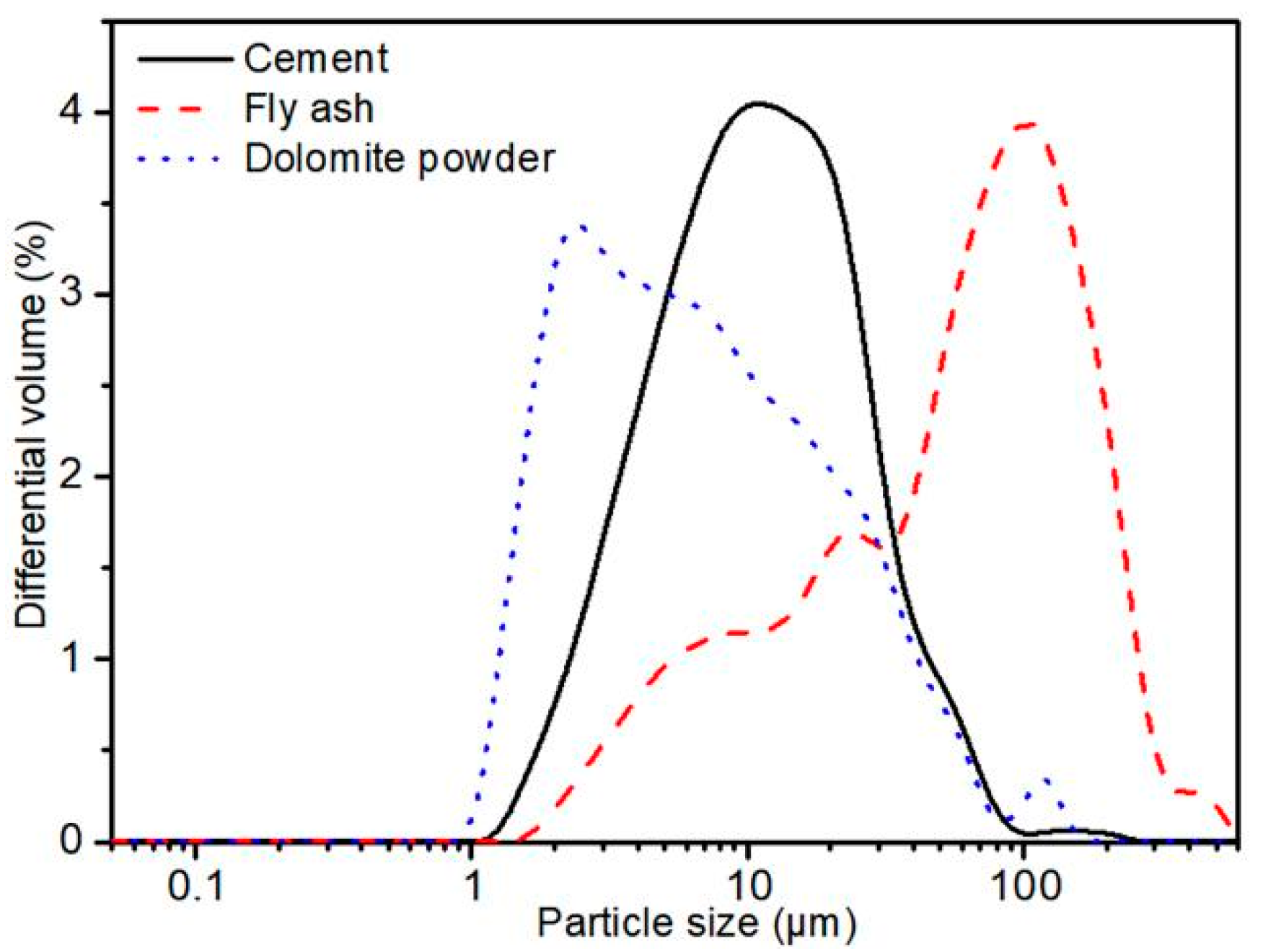
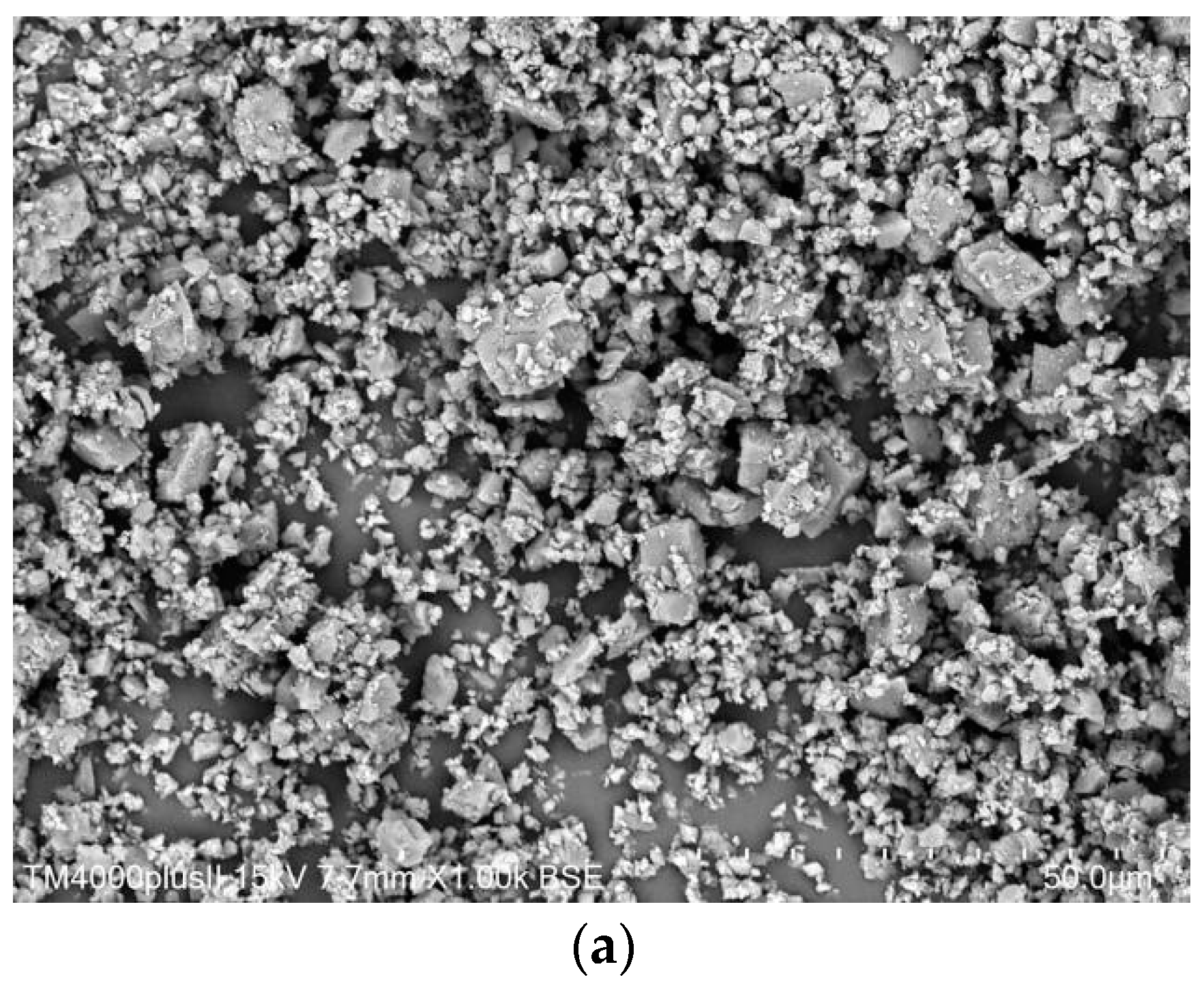
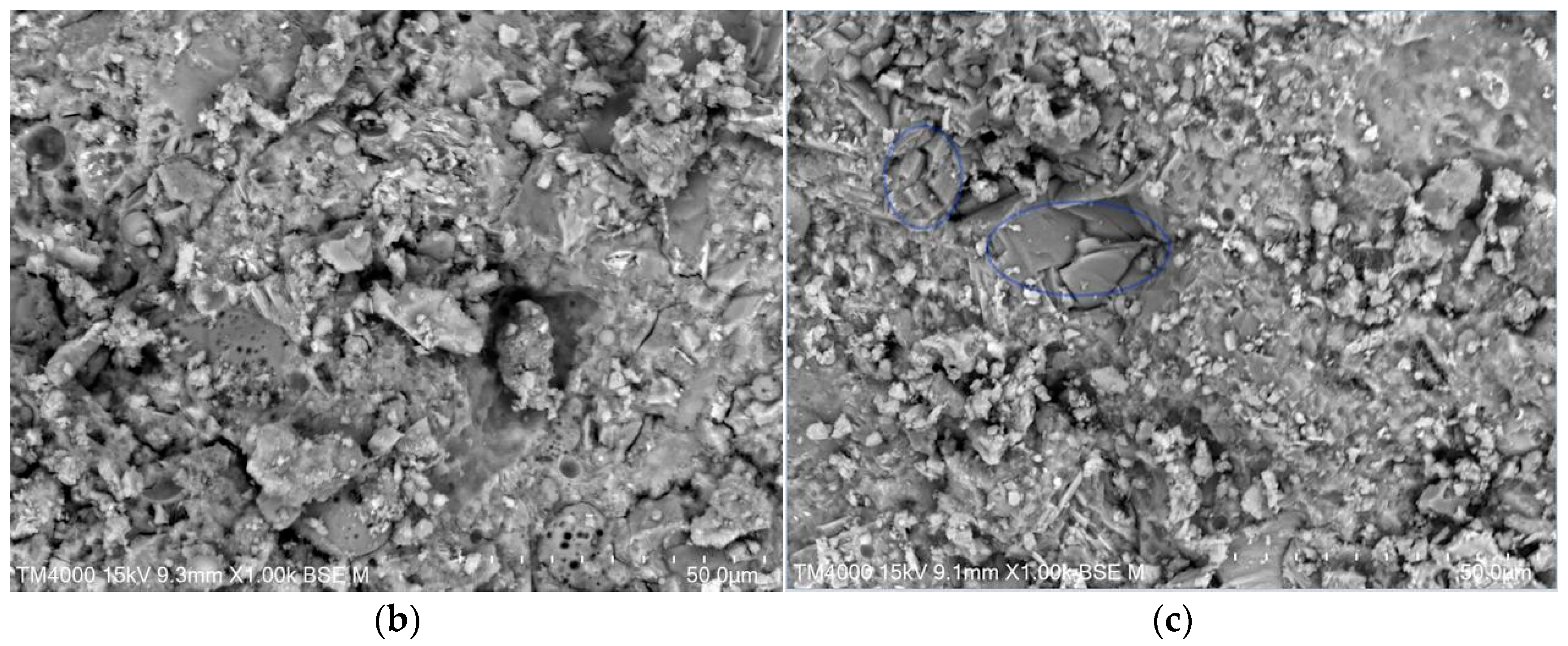


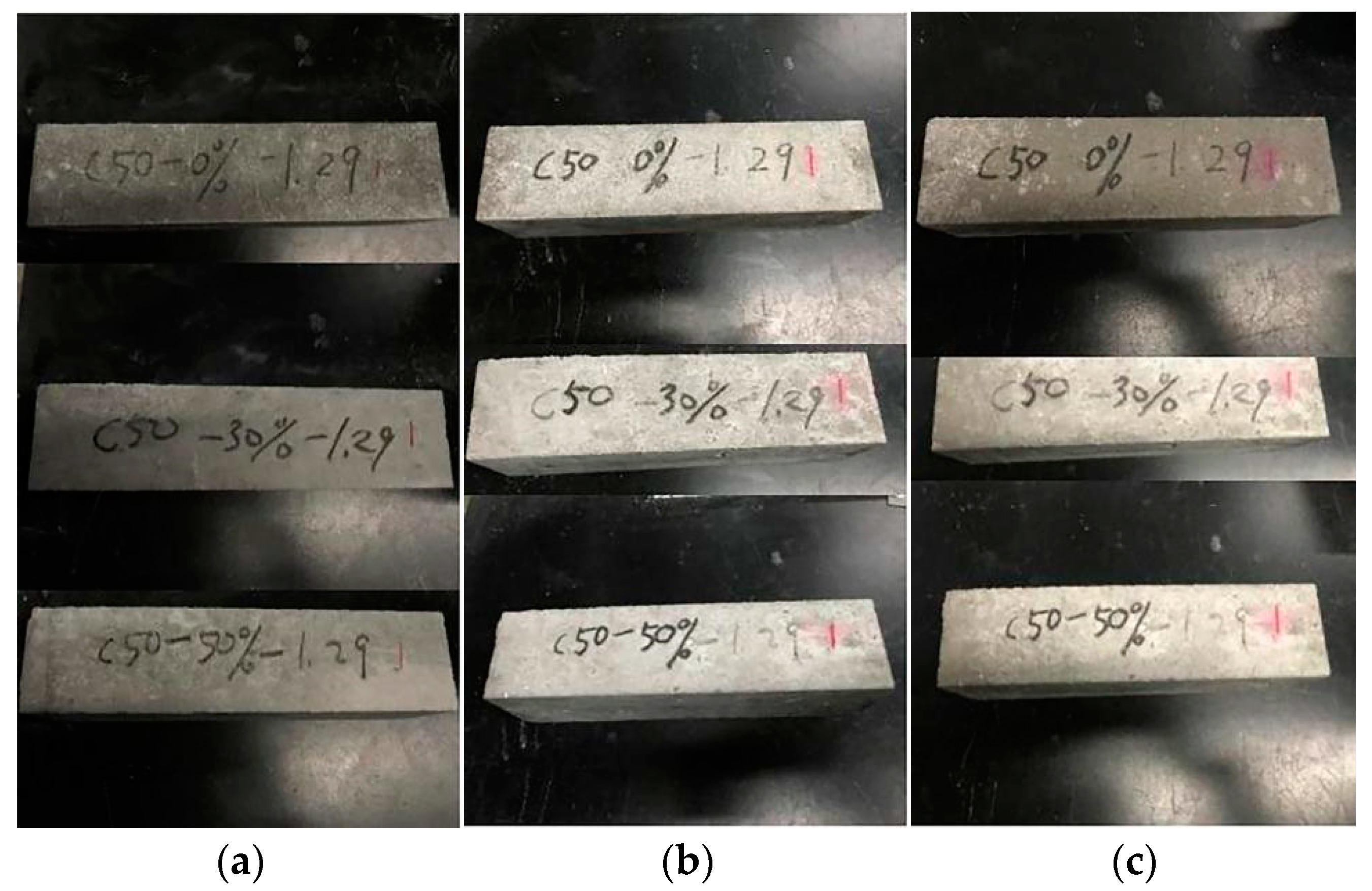
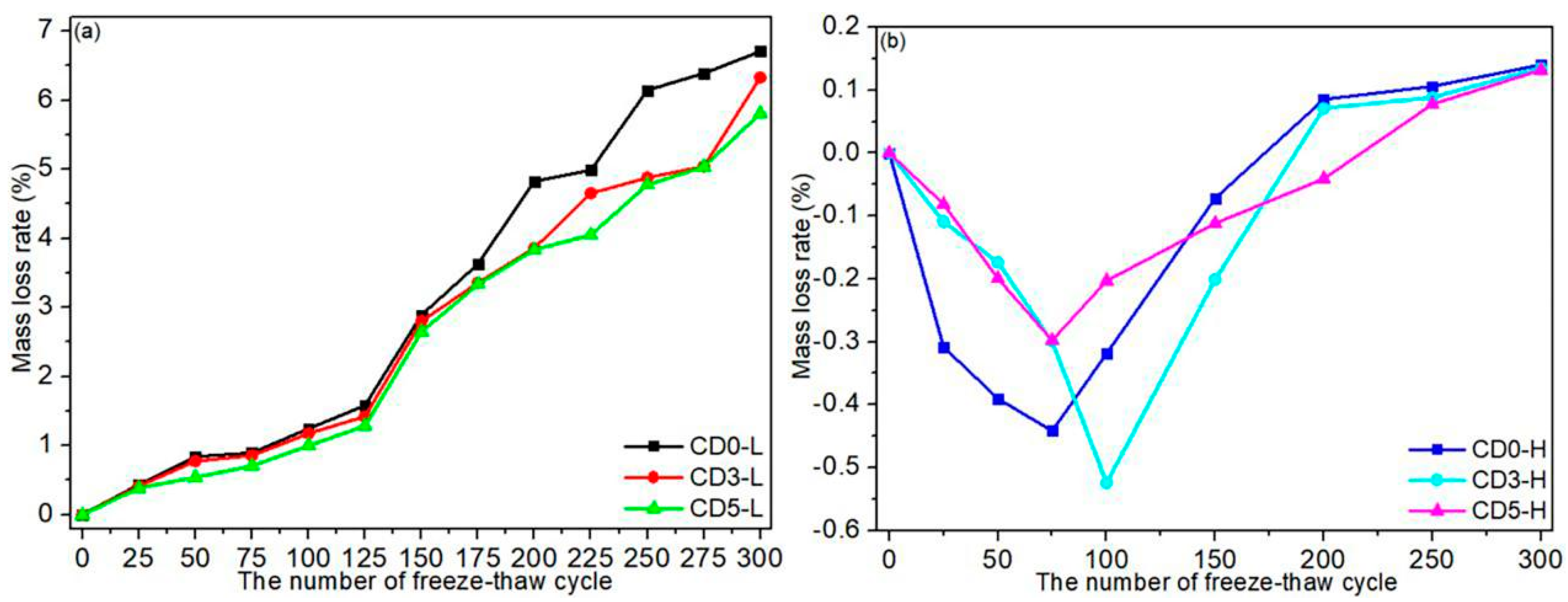
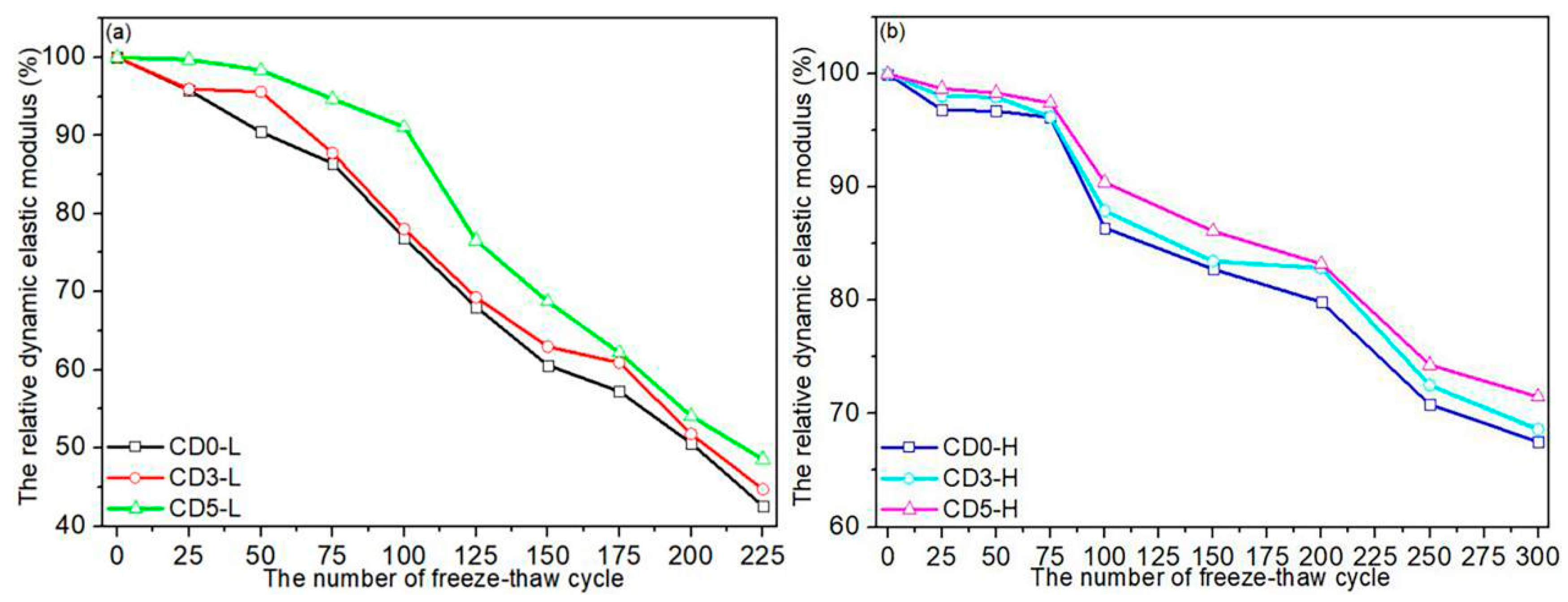
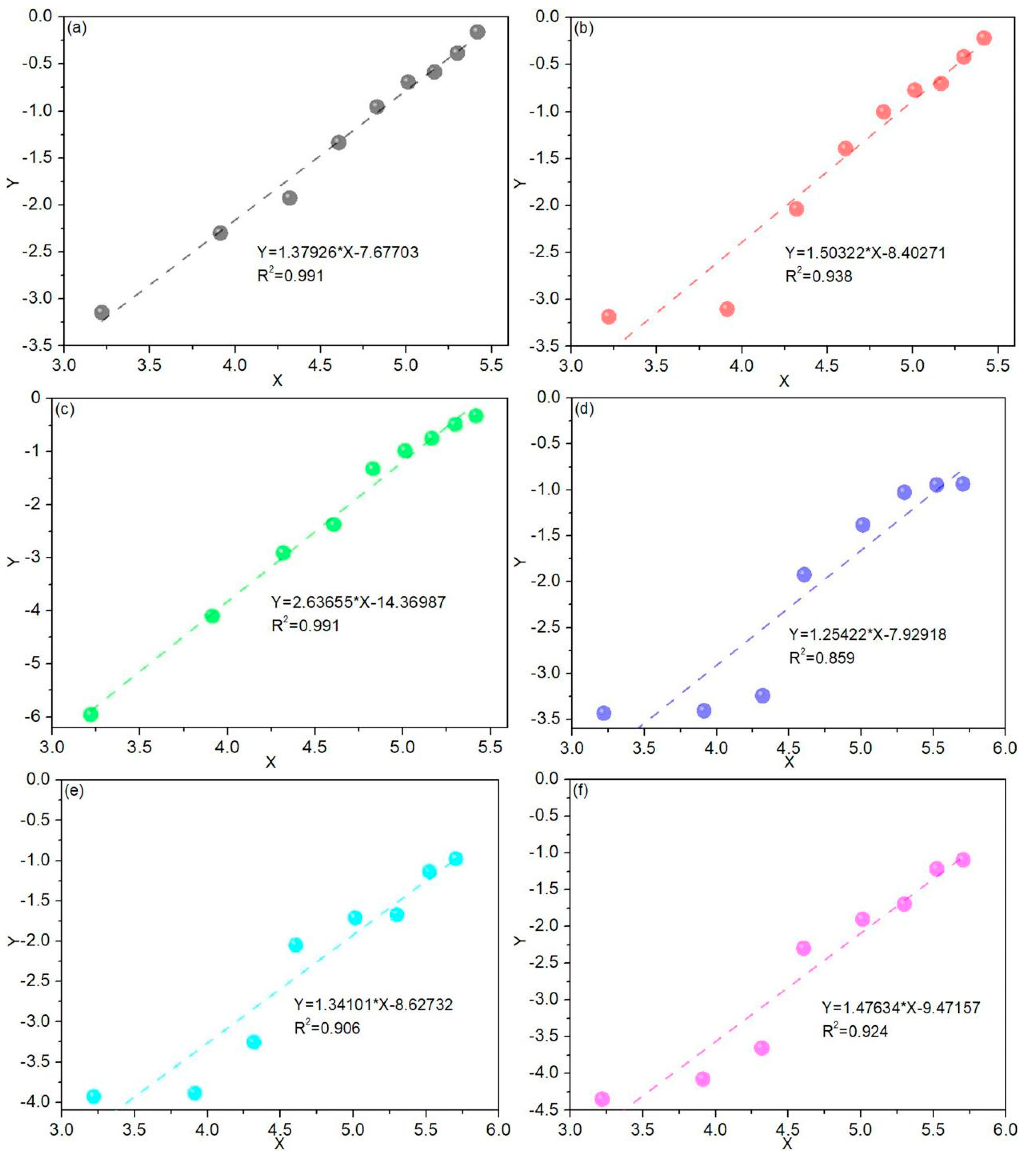

| LOI | SiO2 | Al2O3 | CaO | f-CaO | Fe2O3 | MgO | Na2O | SO3 | Cl |
|---|---|---|---|---|---|---|---|---|---|
| 1.33 | 22.37 | 4.36 | 61.08 | 0.86 | 3.38 | 2.43 | 0.51 | 2.45 | 0.01 |
| CO2 | N | Na2O | MgO | Al2O3 | SiO2 | SO3 | K2O | CaO | Fe2O3 | SrO |
|---|---|---|---|---|---|---|---|---|---|---|
| 45.97 | 1.08 | 0.02 | 18.62 | 0.21 | 0.03 | 0.04 | 0.02 | 33.65 | 0.04 | 0.02 |
| TiO2 | K2O | CeO2 | MgO | Al2O3 | SiO2 | SO3 | P2O5 | CaO | Fe2O3 | SrO |
|---|---|---|---|---|---|---|---|---|---|---|
| 1.08 | 1.00 | 0.09 | 1.87 | 30.72 | 51.20 | 0.78 | 0.59 | 5.53 | 4.70 | 0.09 |
| Specimen | w/b | Dolomite | Cement | Fly Ash | Water |
|---|---|---|---|---|---|
| PDF0 | 0.36 | 0 | 1 | 0.25 | 0.36 |
| PDF3 | 0.36 | 0.375 | 1 | 0.25 | 0.36 |
| PDF5 | 0.36 | 0.625 | 1 | 0.25 | 0.36 |
| Specimen | w/b | Dolomite (kg/m3) | Cement (kg/m3) | Fly ash (kg/m3) | Water (kg/m3) | Sand (kg/m3) | Gravel (kg/m3) | Superplasticizer (kg/m3) |
|---|---|---|---|---|---|---|---|---|
| CD0-L | 0.55 | 0 | 276 | 69 | 190 | 640 | 1188 | 0 |
| CD3-L | 0.55 | 97 | 256 | 64 | 176.2 | 597 | 1188 | 0 |
| CD5-L | 0.55 | 155 | 246 | 61 | 169 | 573 | 1188 | 0 |
| CD0-H | 0.36 | 0 | 350 | 88 | 157.7 | 640 | 1188 | 17 |
| CD3-H | 0.36 | 120 | 324 | 81 | 145.8 | 600 | 1188 | 20 |
| CD5-H | 0.36 | 190 | 307 | 78 | 138.6 | 560 | 1188 | 21 |
| Sample | β | a | α | R2 |
|---|---|---|---|---|
| CD0-L | 1.37926 | –7.67703 | 261.39951 | 0.991 |
| CD3-L | 1.50322 | –8.40271 | 267.68401 | 0.938 |
| CD5-L | 2.63655 | –14.36987 | 232.81754 | 0.991 |
| CD0-H | 1.25422 | –7.92918 | 556.68577 | 0.859 |
| CD3-H | 1.34101 | –8.62732 | 622.31688 | 0.906 |
| CD5-H | 1.47634 | –9.47157 | 611.29215 | 0.924 |
| Sample | Calculated Value | Experimental Value |
|---|---|---|
| CDF0-L | 161 | 150 |
| CDF3-L | 171 | 175 |
| CDF5-L | 180 | 175 |
| CDF0-H | 326 | - |
| CDF3-H | 377 | - |
| CDF5-H | 389 | - |
Publisher’s Note: MDPI stays neutral with regard to jurisdictional claims in published maps and institutional affiliations. |
© 2022 by the authors. Licensee MDPI, Basel, Switzerland. This article is an open access article distributed under the terms and conditions of the Creative Commons Attribution (CC BY) license (https://creativecommons.org/licenses/by/4.0/).
Share and Cite
Zhang, X.; Luo, Y.; Yao, W. An Innovative Material with Strong Frost Resistance—Concrete Containing Dolomite Powder. Materials 2022, 15, 1721. https://doi.org/10.3390/ma15051721
Zhang X, Luo Y, Yao W. An Innovative Material with Strong Frost Resistance—Concrete Containing Dolomite Powder. Materials. 2022; 15(5):1721. https://doi.org/10.3390/ma15051721
Chicago/Turabian StyleZhang, Xin, Yu Luo, and Wu Yao. 2022. "An Innovative Material with Strong Frost Resistance—Concrete Containing Dolomite Powder" Materials 15, no. 5: 1721. https://doi.org/10.3390/ma15051721






